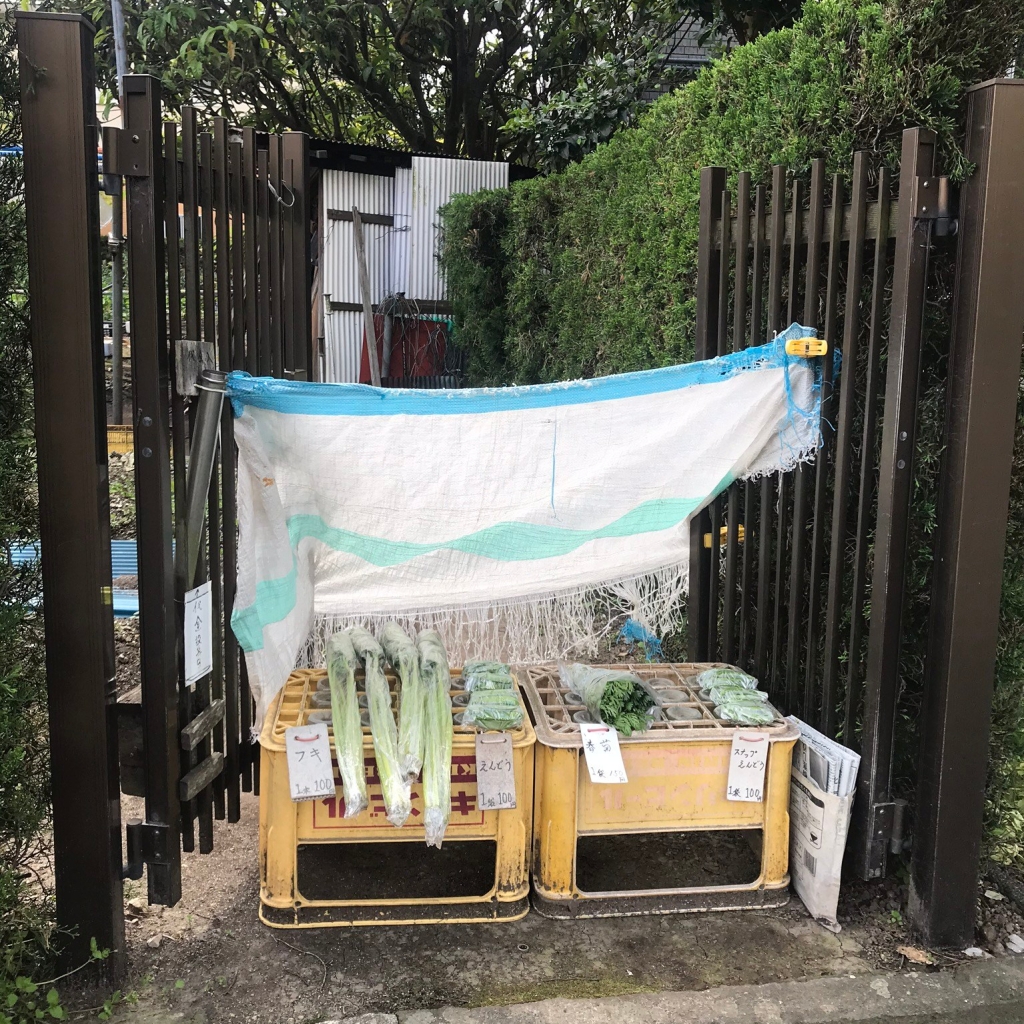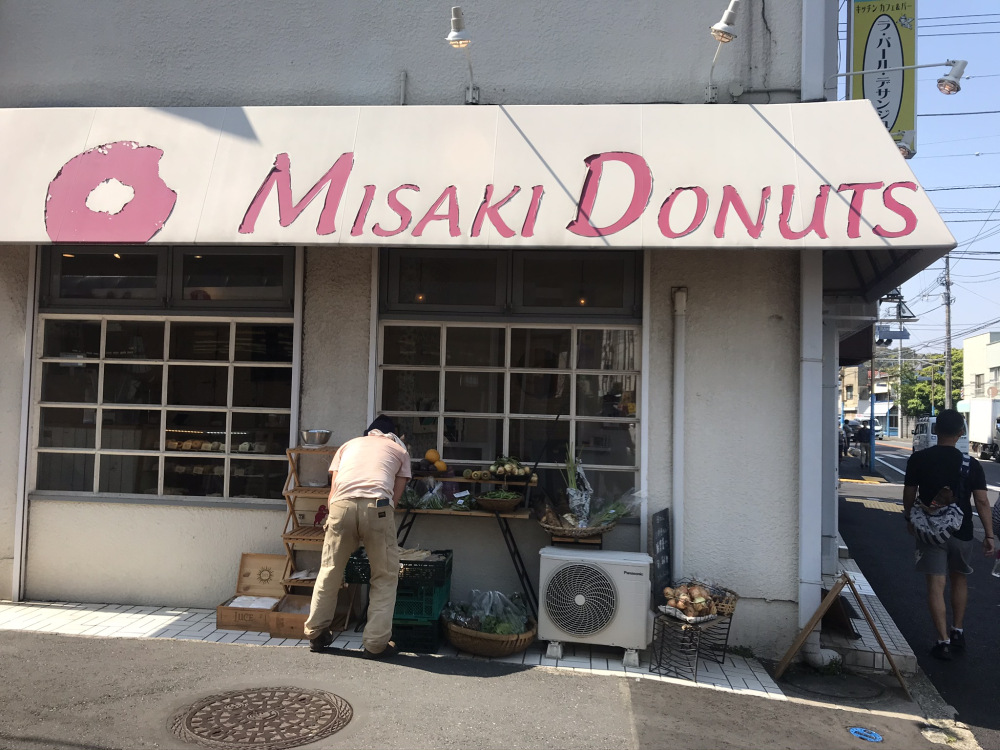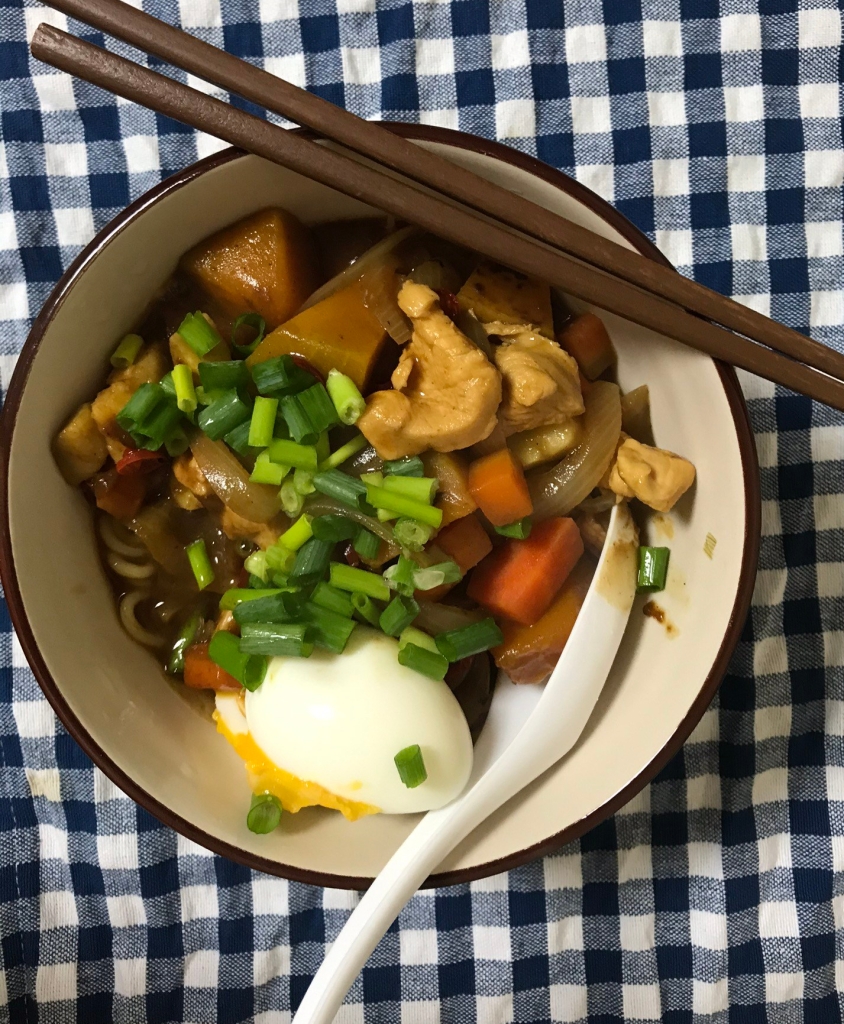Foster and I like Japanese food. Indeed, we’ve cooked and eaten Japanese food exclusively since we got here. In the course of our culinary adventures, I’ve realized a few things:
- We don’t know much about Japanese food, and by we, I mean Foster, me, and probably much of the rest of the United States.
- Japanese food is much simpler to cook than you might think — sometimes shockingly so.
Since we’re staying home, grocery shopping is our biggest outing. Zushi has a few larger full-service grocery stores and a number of smaller ones. We started off going to the big grocery store in town, but quickly abandoned that plan because although OKMart is well stocked, it’s crowded. It’s impossible to leave six feet between yourself and everyone else. In recent weeks, we’ve therefore done our shopping at open-air veggie and fruit stalls, and a small grocery store close to our house called Gyunyu Supa (supa is a contraction of “supermarket” in Japanese).
Grocery shopping in Japan is a humbling and fascinating experience. I’m functionally illiterate, but I try to get by without using the Google Translate app on my phone. It’s only moderately useful at best — consider it’s rendition of our washing machine buttons as proof. According to Google, these include “it’s a sheep” and “machine wash yourself.” I’m on my own here, and that means that I’m limited to what I can read in hiragana (loopy letters) and katakana (sharp, stabby letters).
Even with that handicap, it has been a delicious adventure getting to know all the various treats hiding in the typical Japanese grocery store. We’ve been amazed by the diversity of mentsuyu, or noodle dipping sauces. Yes, you can easily make these at home, but why not at least try one or two of the ten available bottles? The same goes for ponzu, a citrusy umami-type sauce that is available in at least eight kinds of bottles, large and small.

Before we arrived, I had assumed that Foster would take cooking classes and learn how to make all kinds of Japanese food. I figured I’d learn along the way, benefiting from his training. Instead, we’ve been using each lunch and dinner as an excuse to try out a new Japanese dish. Even if we wanted to eat out, options are limited and far more available at midday, when restaurants sell bento boxes to go. Hence, we’ve dived in and started cooking with help from a few websites, including Just One Cookbook and Japan Centre. Curry, yakisoba, ponzu stirfries, chankonabe (sumo stew), miso, tamagoyaki — you name it, we try it. And when we can’t try it, we buy it (hello, sushi).
Japanese food in the US is variously trendy (macrobiotics) or sophisticated/hip (sushi). Common wisdom is that Japanese food is above all else healthy — how else would Japanese people enjoy the longest life expectancy on planet earth? Japan’s average life expectancy was 84.55 years in 2019, up .014% from 2018. Oliver Wendell Holmes helpfully observed that “No generalization is worth a damn, including this one,” and while it is true that a great deal of Japanese food is indeed salubrious, this country also does marvelous things with cream and sugar, about which I’ll comment in a future post. There are three big trends that I’d wager help prop up Japan’s long life expectancy numbers:
- Vegetables are very affordable. It’s possible to buy a bag of leafy greens sufficient to generate 2-3 meals for two people for less than $1.50. Three or four large carrots can be had for about the same. A bag of bean sprouts costs 35 cents. A bag of 4-5 small sweet green peppers is less than $2, and a big hunk of daikon (Japanese radish) is less than 75 cents.
- Fermented foods are big. Natto (fermented soy beans) are cheap, widely available, and delicious. A three-pack at the grocery store costs about 40 cents. Kimchi is easy to find, and though it’s a staple in Korea, it’s also quite popular here. Miso is everywhere, and homemade miso paste isn’t hard to come by. Yogurt is also widely available.
- Everyone walks or bikes. Everywhere. All. The. Time. More about this later, as it has implications for transportation and social distancing.
In the US, I’ve read that people are advised to shop for two week’s worth of groceries. We don’t have the space to do that — our fridge provides 3.75 square feet of storage space, plus a freezer that’s maybe half that big. I should note that as with our Zushi apartment, our fridge seems huge. In Tokyo, our fridge was a 3’x3′ college beer fridge. We have one cabinet where we store our dry goods, like panko bread crumbs, potato starch, curry roux and snacks. Even in a pandemic, when you have a small fridge, you have to shop more often. We’ve found that we can go about a week before we need to restock our veggies, tofu, natto and the like.
All rules are off during a pandemic, but it’s worth noting that a Toronto architect hypothesizes that “small fridges make good cities.” He uses Denmark and other European countries as prime examples, but I can see how the argument applies here. Were it not for COVID-19, we’d be shopping every other day and buying smaller amounts. As it is, we buy from local merchants, whose stalls are not only en plein aire, but in good times, keep streets busy and engaging.
We’re also fortunate that we can grocery shop in the U.S. when needed, since as a Coast Guard veteran, Foster has access to the commissary at Yokosuka Naval Station, which is about 7 miles away. Rationing is in effect, but at least at the commissary, we can find hand soap, hand sanitizer, bleach wipes, and most importantly, chunky peanut butter. The Naval Station is also probably the only place Foster can find clothes, given that at 6′ 4″ he towers above most Japanese people. Even the doorways in our apartment are 3-4 inches too short for him, poor guy. At least he eats well here in Japan.


Quick reads